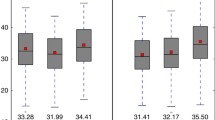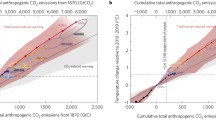Abstract
Stabilization of atmospheric CO2 concentrations below a pre-industrial doubling (~550 ppm) is a commonly cited target in climate policy assessment. When the rate at which future emissions can fall is assumed to be fixed, the peak atmospheric concentration – or the stabilization “frontier” – is an increasing and convex function of the length of postponement. Here we find that a decline in emissions of 1% year−1 beginning today would place the frontier near 475 ppm and that when mitigation is postponed, options disappear (on average) at the rate of ~9 ppm year−1, meaning that delays of more than a decade will likely preclude stabilization below a doubling. When constraints on the future decline rate of emissions are relaxed, a particular atmospheric target can be realized in many ways, with scenarios that allow longer postponement of emissions reductions requiring greater increases in the intensity of future mitigation. However, the marginal rate of substitution between future mitigation and present delay becomes prohibitively large when the balance is shifted too far toward the future, meaning that some amount of postponement cannot be fully offset by simply increasing the intensity of future mitigation. Consequently, these results suggest that a practical transition path to a given stabilization target in the most commonly cited range can allow, at most, one or two decades of delay.
Similar content being viewed by others
References
Alcamo J, Kreileman E (1996) Emission scenarios and global climate protection. Glob Environ Change 6:305–334
Corfee-Morlot J, Hohne N (2003) Climate change: long-term targets and short-term commitments. Glob Environ Change 13:277–293
Dessai S (2004) Defining and experiencing dangerous climate change. Clim Change 64:11–25
Gregory JM, Huybrechts P, Raper SCB (2004) Threatened loss of the Greenland ice-sheet. Nature 428:616
Ha-Duong M, Grubb MJ, Hourcade J-C (1997) Influence of socioeconomic inertia and uncertainty on optimal CO2-emission abatement. Nature 390:270–273
Hansen J (2004) Defusing the global warming time bomb. Sci Am 290:68–77
Hansen J (2005) A slippery slope: how much global warming constitutes “dangerous anthropogenic interference”? Clim Change 68:269–279
Hoegh-Guldberg O (1999) Climate change, coral bleaching and the future of the world’s coral reefs. Mar Freshw Res 50:839–866
Houghton JT et al (ed) (2001) Climate change 2001: the scientific basis. Cambridge University Press, Cambridge, UK
Keeling CD, Whorf TP (2005) Atmospheric CO2 records from sites in the SIO air sampling network. In: Trends: a compendium of data on global change, carbon dioxide information Analysis Center. Oak Ridge National Laboratory, US Department of Energy, Oak Ridge, TN. Digital data available at http://cdiac.ornl.gov/trends/co2/sio-mlo.htm
Mignone BK, Gnanadesikan A, Sarmiento JL, Slater RD (2006) Central role of Southern Hemisphere winds and eddies in modulating the oceanic uptake of anthropogenic carbon. Geophys Res Lett 33:L01604
O’Neill BC, Oppenheimer M (2002) Dangerous climate impacts and the Kyoto Protocol. Science 296:1971–1972
O’Neill BC, Oppenheimer M (2004) Climate change impacts are sensitive to the concentration stabilization path. Proc Nat Acad Sci USA 101:16411–16416
Oppenheimer M (1998) Global warming and the stability of the West Antarctic ice sheet. Nature 393:325–332
Oppenheimer M (2005) Defining dangerous anthropogenic interference: the role of science, the limits of science. Risk Anal 25:1399–1407
Oppenheimer M, Alley RB (2004) The West Antarctic ice sheet and long-term climate policy. Clim Change 64:1–10
Oppenheimer M, Petsonk A (2005) Article 2 of the UNFCCC: historical origins, recent interpretations. Clim Change 73:195–226
Orr JC et al (2000) Abiotic how-to document. Text available at http://www.ipsl.jussieu.fr/OCMIP
Pacala S, Socolow R (2004) Stabilization wedges: solving the climate problem for the next 50 years with current technologies. Science 305:968–972
Richels R, Edmonds J (1995) The economics of stabilizing atmospheric CO2 concentrations. Energy Policy 23:373–378
Shafer G, Sarmiento JL (1995) Biological cycling in the global ocean 1. A new analytical model with continuous vertical resolution and high-latitude dynamics. J Geophys Res 100:2659–2672
Siegenthaler U, Joos F (1992) Use of a simple model for studying ocean tracer distributions and the global carbon cycle. Tellus 44B:186–207
Socolow RH, Lam SH (2007) Good enough tools for global warming policy making. Philos Trans R Soc Lond A 365:897–934
Stocker TF, Schmittner A (1997) Influence of CO2 emission rates on the stability of the thermohaline circulation. Nature 388:862–865
United Nations Framework Convention on Climate Change (UNFCCC) (1992) Text available at http://www.unfccc.int
Wanninkhof R (1992) Relationship between wind speed and gas exchange over the ocean. J Geophys Res 97:7373–7382
Watson RT et al (2001) Climate change 2001: the synthesis report. Cambridge University Press, Cambridge, UK
Webster M (2002) The curious role of learning in climate policy: should we wait for more data? Energy J 23:97–119
Wigley TML, Richels R, Edmonds JA (1996) Economic and environmental choices in the stabilization of atmospheric CO2 concentrations. Nature 379:240–243
Yohe G, Andronova S, Schlesinger M (2004) To hedge or not against an uncertain climate future? Science 306:416–417
Zeebe RE, Wolf-Gladrow D (2003) CO2 in seawater: equilibirum, kinetics, isotopes. Elsevier, Amsterdam
Author information
Authors and Affiliations
Corresponding author
Rights and permissions
About this article
Cite this article
Mignone, B.K., Socolow, R.H., Sarmiento, J.L. et al. Atmospheric stabilization and the timing of carbon mitigation. Climatic Change 88, 251–265 (2008). https://doi.org/10.1007/s10584-007-9391-8
Received:
Accepted:
Published:
Issue Date:
DOI: https://doi.org/10.1007/s10584-007-9391-8




